On September 20, 1808, the President sent this to the inhabitants of Kingston in response to their earlier petition about the Embargo Act of 1807. As form letters go, this is a good one.
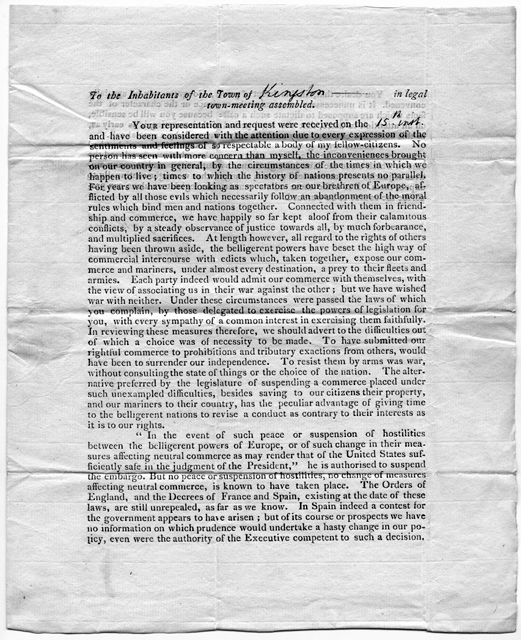
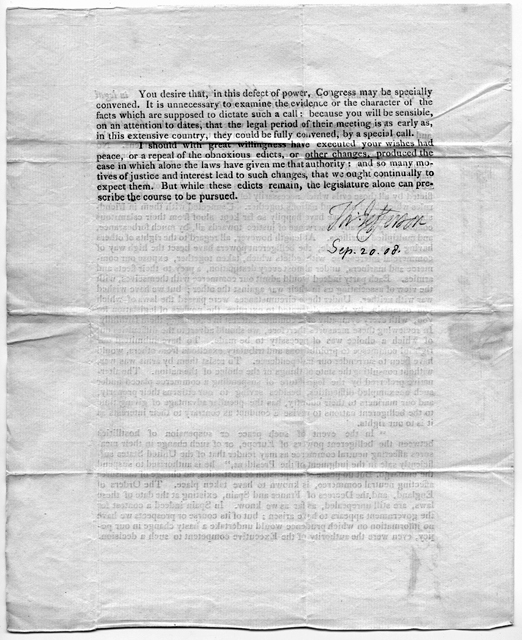
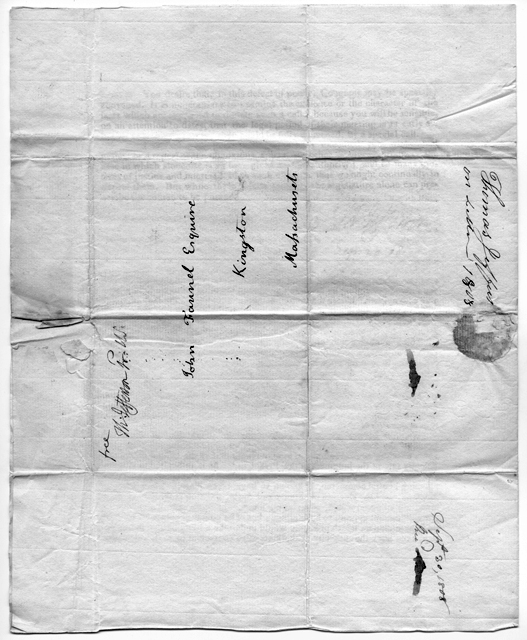
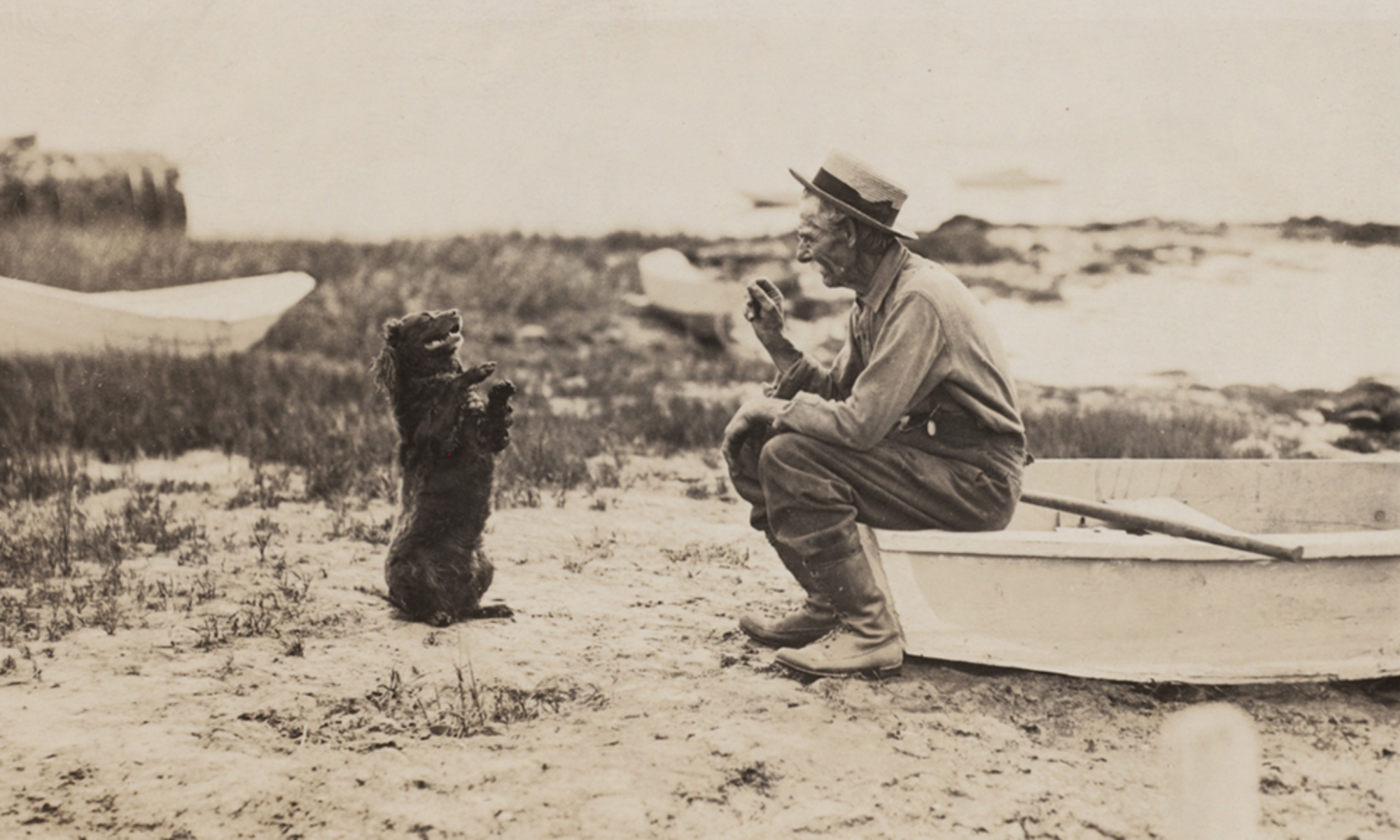
Kingston (Massachusetts) Public Library
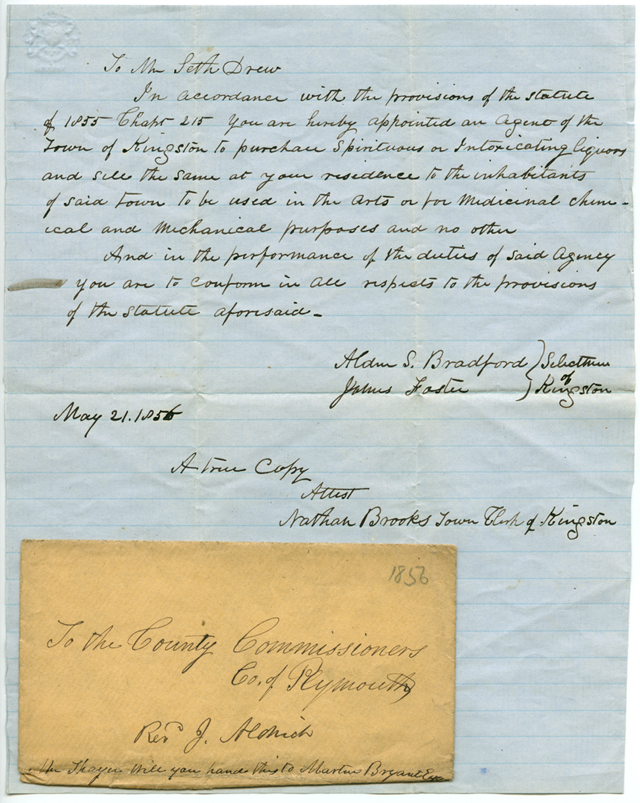
To Mr. Seth Drew
In accordance with the provisions of the statues of 1855 Chap. 215 you are hereby appointed an Agent of the Town of Kingston to purchase Spiritous or Intoxicating liquors and sell the same at your residence to the inhabitants of said town to be used in the Arts or for Medicinal chemical and Mechanical purposes and no other.
And in the performance of the duties of said Agency you are to conform in All respects to the provisions of the statute aforesaid.
Alden S. Bradford, James Foster, Selectmen of Kingston
May 21, 1856
A true Copy Attest, Nathan Brooks Town Clerk of Kingston.
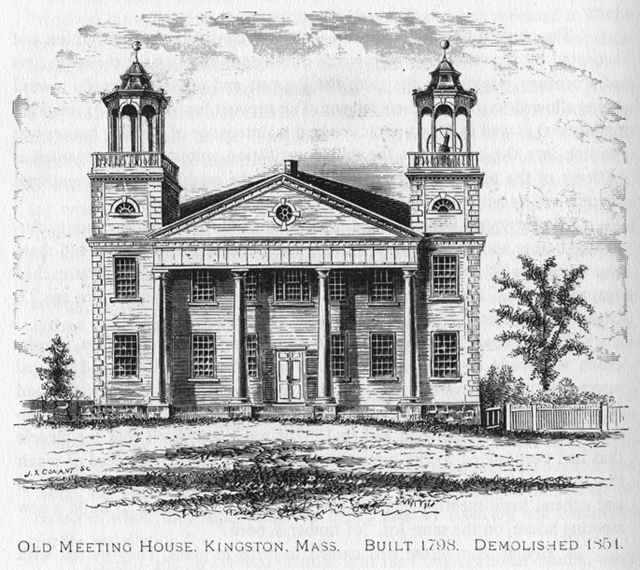
This is the Second Meeting House, which stood where the First Parish Church now stands on Main Street, next to the Training Green. It served not only as the second building to house the First Parish, but also as the center of Kingston’s town government before the original Town House was built. We know a few things about it. There is the drawing above. There are written descriptions. Doris Johnson, in Major Bradford’s Town, gives the specifics of the 1798 “plans for a structure 60 feet by 55 feet and 25 feet high, with ‘projectments to be 10 feet added’.” Further, she quotes Sarah Bailey in Civic Progress.
This was the large meeting house with the two belfries known to this generation only by pictures…It was unique in its exterior form, but inside it was a typical New England meeting house with high pulpit and sounding board, galleries on three sides, and square pews with doors and the seats that were raised while the congregation stood during the long prayer.
Mrs. Bailey’s generation may have known the Second Meeting House by pictures, but viewers in this century knew only the one drawing and the words.
Until last week…
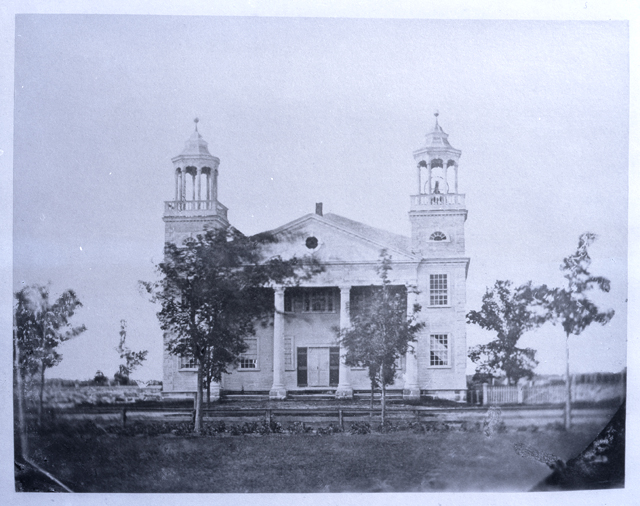
Part of a large new collection, the heavy celluloid negative from which this scan was made is a copy because film negatives did not appear until the 1880s, but the building was demolished in 1851. This image might even have been made before 1841, when the Old Town House was built: it would have stood to the right and behind the Second Meeting House in this view. That may be the sum of what we will ever know about this negative. Still for all the questions and all the unknowns, we now have a photograph that once disappeared into history, but has now emerged.
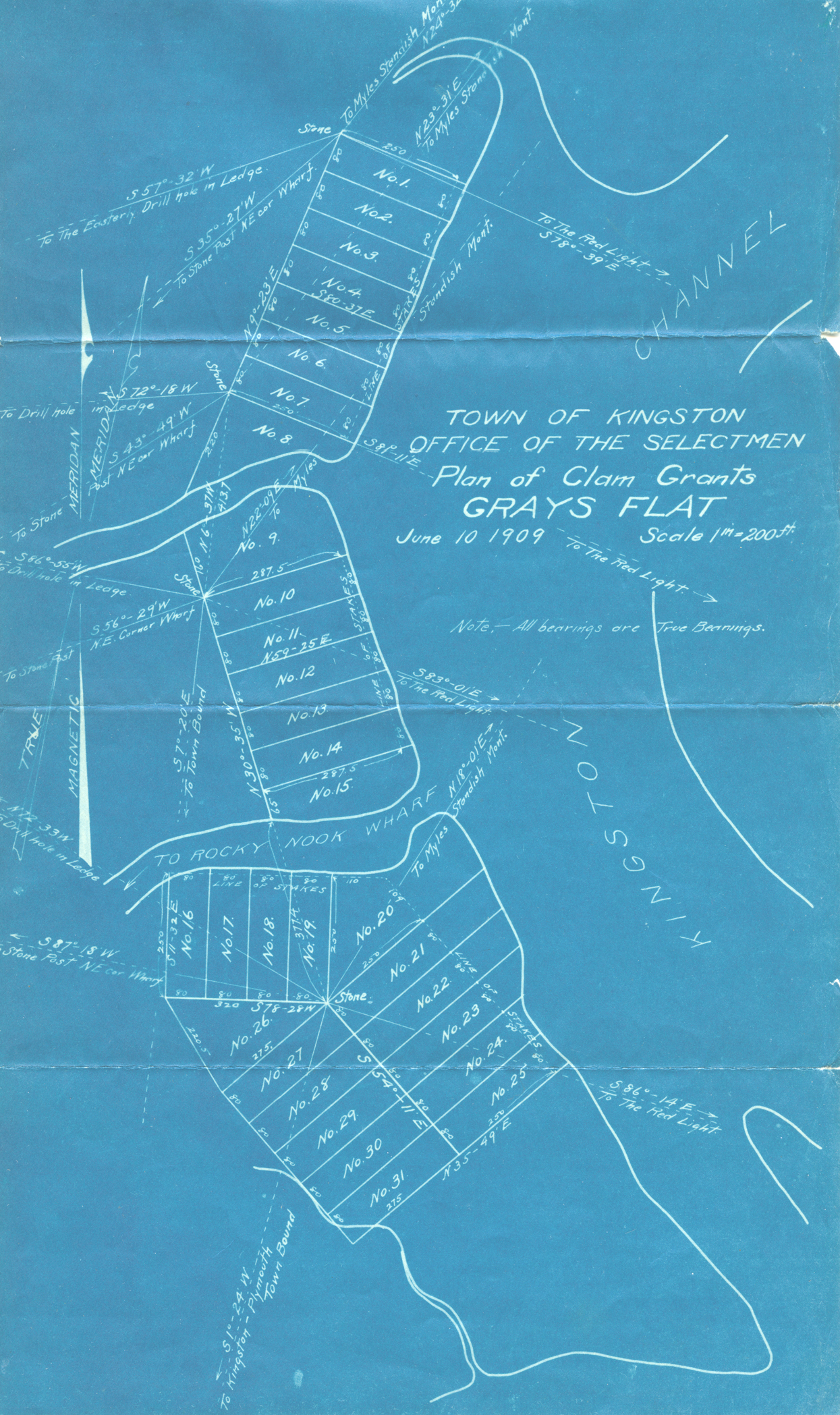
Throughout the 1800s, Kingston, along with Plymouth and Duxbury, provided clams to cod fisheries all along the Massachusetts coast. Clams were sold fresh for bait in the winter months, or steamed, salted and barreled for summer use. The region produced as much as 100,000 bushels a year. Around 1875, the shellfish – steamed and fried – became a sought-after delicacy, not only for New England clam bakes and shore dinners, but also in fancy restaurants in Boston, New York and Chicago for restaurants. Closer to home, shellfish
With Chapter 195 of the Acts of 1870, Massachusetts allowed towns to regulate shellfishing. In 1909, licenses to culture and harvest clams were issued by the Selectmen of Kingston, and the Bay floor was divided among the lucky license holders. The first license was issued to Fred Bailey for “one-half acre more or less.” The division of Gray’s Flats can be seen on the blueprint above.
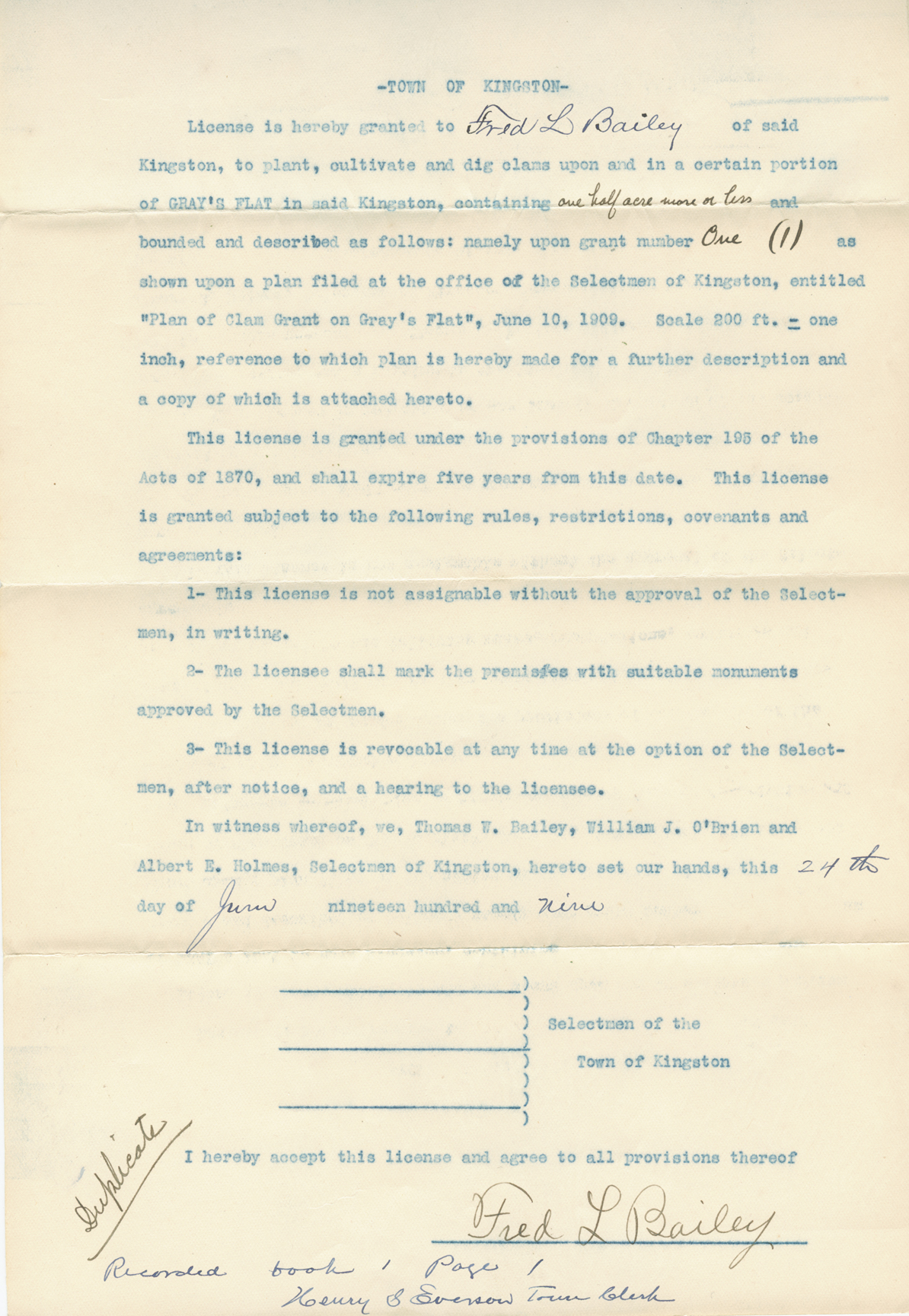
During the 1920s, outbreaks of typhoid fever were traced back to local shellfish and many beds were closed. Some Kingston clam flats have remained closed since that time, while other areas were harvested into the 1970s. As the towns around Kingston, Duxbury and Plymouth Bays grew, pollutants increasingly affected the ecosystem, and shellfishing became hazardous. By 2002, however, efforts to decrease storm drain runoff and regulate septic systems had lowered pollution levels enough to allow Kingston Bay to be seeded with seven tons of cherrystones, quahogs, little necks and soft shell clams. In 2009, Kingston were again issued shellfish licenses, almost 100 years to the day after the original licenses were granted. Aquaculture is a new, and newly revived, industry in Kingston and surrounding towns.
All the recent snow reminded me of this photograph taken from Green Street. It dates after 1883, because the Soldier’s Monument is there, but before 1928, when the trolley stopped running.
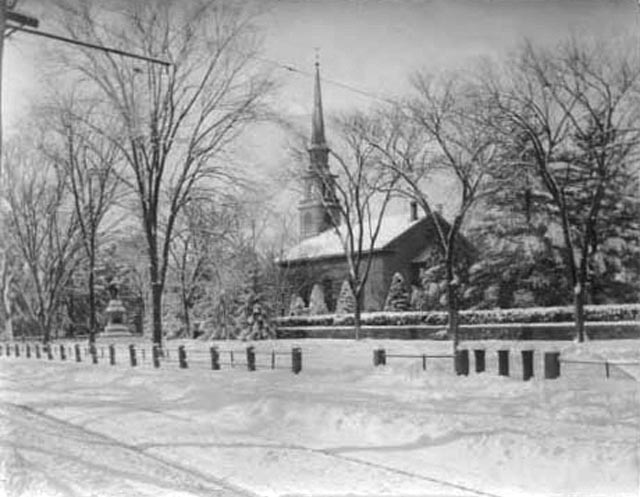
Once I found this one, I walked a little ways down Green Street to see if the view was the same.
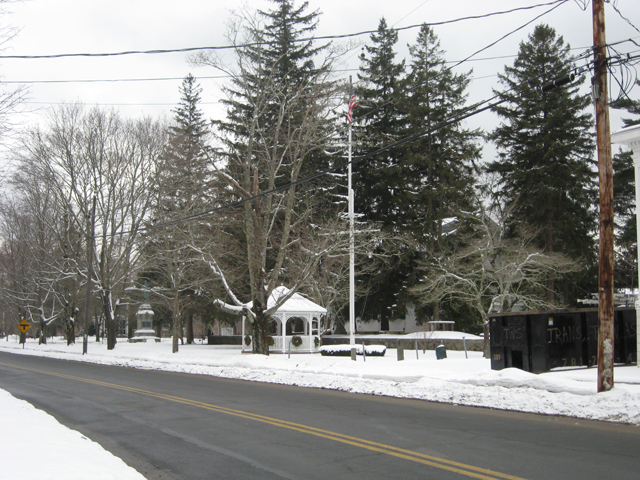
Not exactly.
Published in 1899 by the Commonwealth of Massachusetts’ Topographical Survey Commission, The Atlas of the Boundaries of the Town of Kingston describes the 18 corners marking the town limits and the seven “triangulation stations” used to locate the corners. The Atlas includes the statutes that formally defined the boundaries, textual descriptions, a scale map of the town along with details of each corner, two tables of geographical data and nicely captioned photographs.
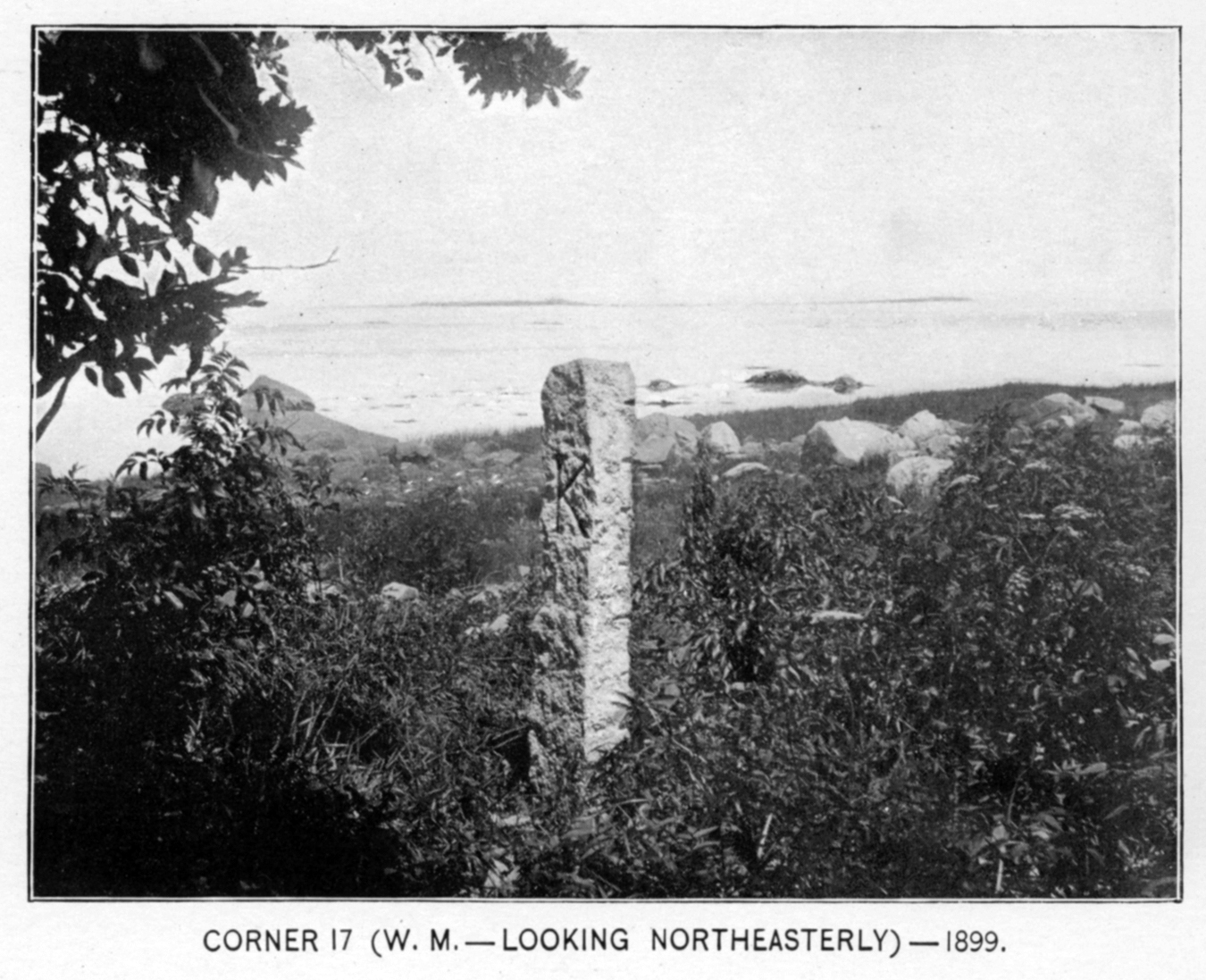
Among the readily identifiable landmarks, such as Monk’s Hill, the Kingston Unitarian Church and the Standish Monument, is one known to many but now gone: Nick’s Rocks.
In the 1920’s Emily Drew wrote
Nick’s Rock on the line between the towns of Plymouth and Kingston, not far from Monk’s Hill is one of three rocks in Kingston which “testify” to the visits of the Devil as imprints of his feet and hooves prove “conclusively” that such visits were really made. The other two rocks are both called Devil’s Rock. One lies near Bay Farm and the other in the brick-kiln pasture near C. Drew and Company on Stony Brook.
Nick’s Rock was also used as a boundary marker for the town line between Plymouth and Kingston. Originally the rock marked the way for Nick’s Rock Road, which was the main road from the early Plymouth settlement. The road branched at the rock with one direction heading towards Plympton and the other towards the Flaxing Place at Smelt Pond.
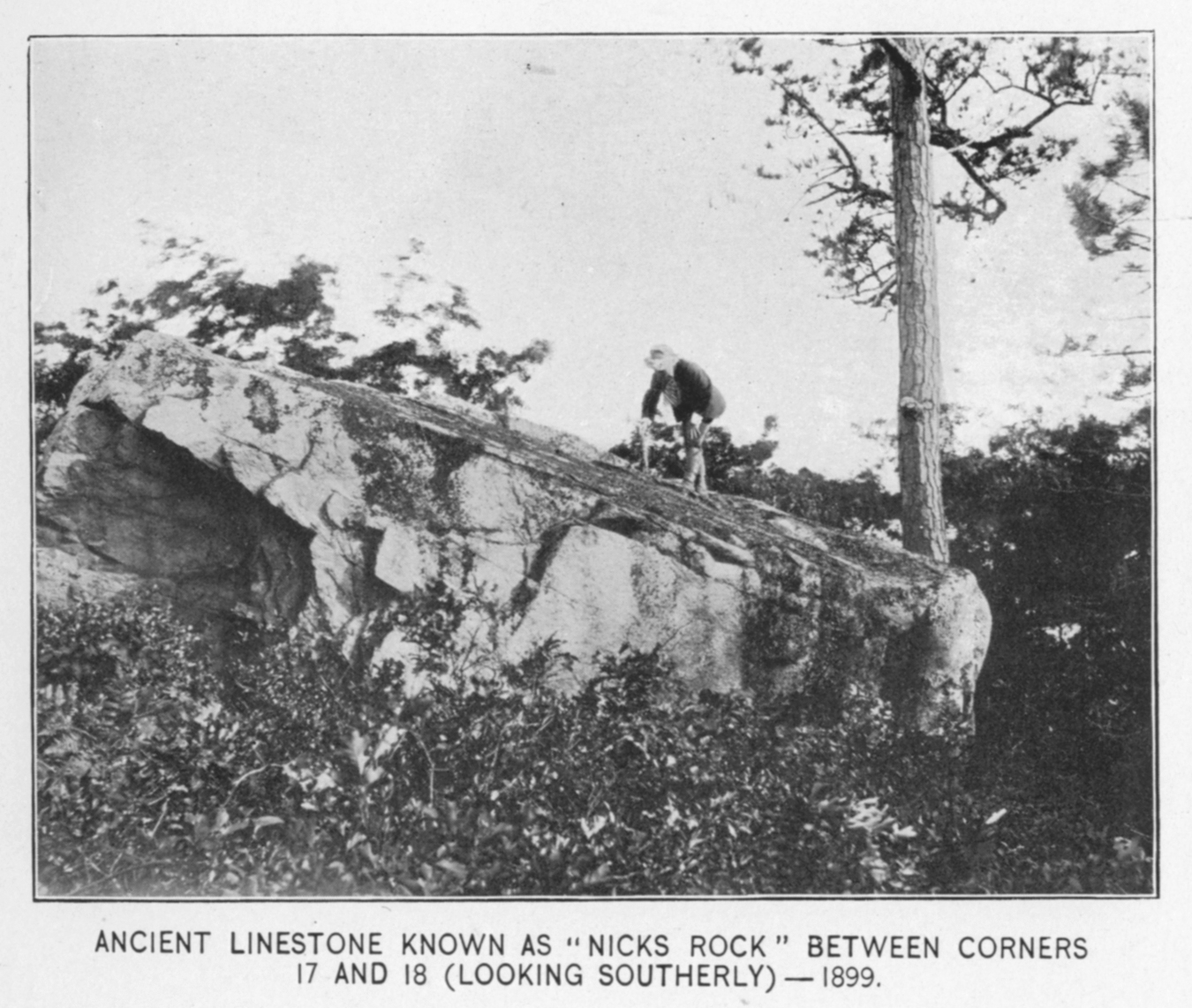
The 1899 Atlas locate Nicks’ Rock on the line between corners 17 and 18, at latitude 41 57 35.95 and longitude 70 42 59.64, and describes the landmark as
situated in the boundary line between Kingston and Plymouth, in a thick growth of low scrub oaks, with scattering yellow pines, about 75 feet west of a wood-road. It is a well know point being marked by a rock about 10 feet high and measuring 12 x 15 feet on the top, which slopes to the southwest. A good view is obtained for miles to the south and west.
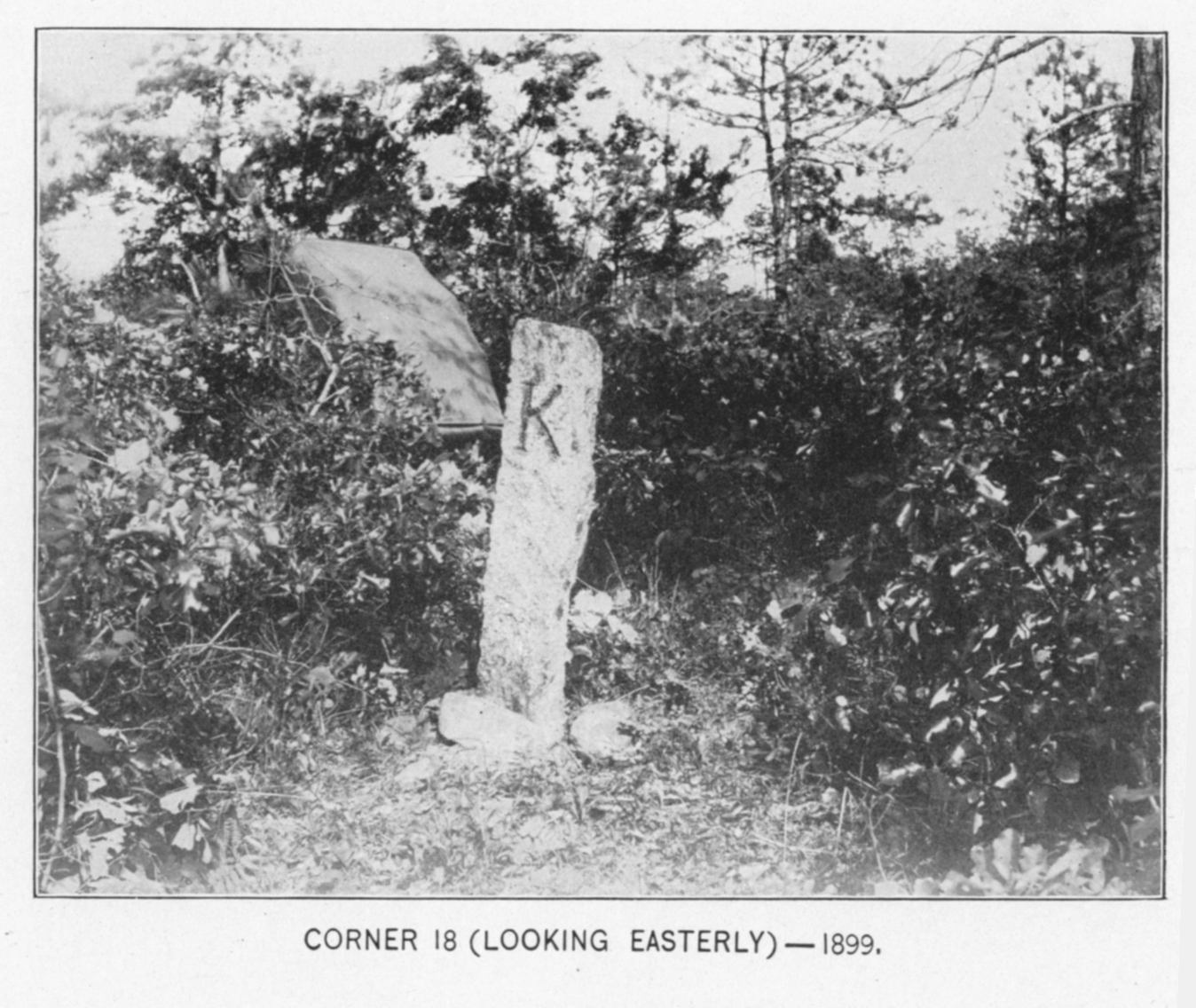
Nick’s Rock is gone now, though a marker in the median strip of the new Route 44 just west of the Cherry Street overpass commemorates this bygone stone.
Long before the Red Sox/Yankees rivalry and even earlier than the infamous trade that took Babe Ruth from Fenway to the Bronx, a profound difference split the game we know as America’s past-time. There were actually two kinds of baseball – the Massachusetts Game and the New York Game. Derived from an earlier version called Town Ball, itself a descendant of the English game of rounders, the Massachusetts Game was not formalized until 1858 (see the rule book here ), while the New York variety followed the rules of the Knickerbocker Club, dated 1845.
The New England version was, in its time considered the rougher, less civilized game, in no small part because the fielders got the baserunner (called a striker) out by hitting him with the ball, a task so difficult that innings ended after only one out and games concluded as soon as one side scored 100 runs, no matter the number of innings completed. After the Civil War, the New York Game surged in popularity and crowded out the Massachusetts style.
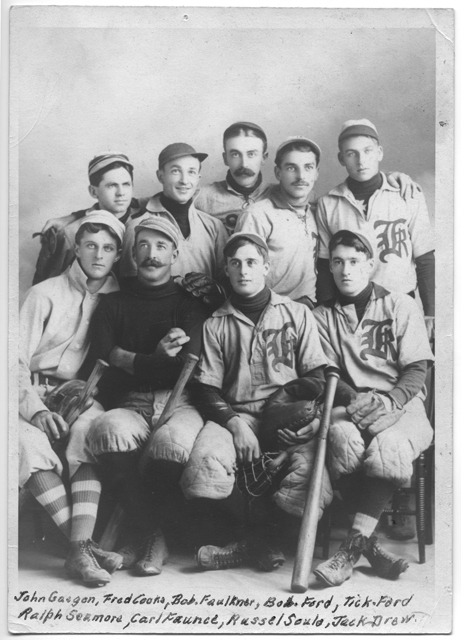
Kingston had a town team by the last years of the 19th century, but very little information, beyond the names added to this photograph, can be found in the Local History Room. We do know that Bob Ford graduated from Kingston High School in 1898 (a classmate of Emily Fuller Drew), while Tick Ford (real name Winthrop) crewed on Henry Jones’ sail boat Kittiwake V and later served as a Kingston Water Commissioner. Based on their equipment, it seems that Carl Faunce pitched while Russel Soule caught. Otherwise, the exploits of the Kingston Town Team remain a mystery to us today.
Players: (standing left to right) John Gaegon, Fred Cooke, Bob. Faulkner, Bob. Ford, Tick Ford. (seated left to right) Ralph Seamore, Carl Faunce, Russel Soule, Jack Drew
The Pumping Station
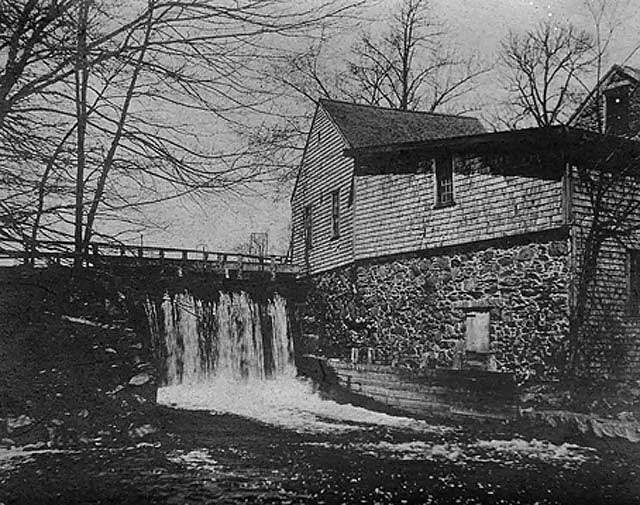
Kingston’s municipal water system was proposed at Town Meeting in 1884, legislated in 1885 under “An Act to Supply the Town of Kingston with Water,” and implemented in 1886. The system officially began operations on August 10 that year. While the actual water supply came from wells, Jones River water power supplied the mains and the reservoir (see this earlier post) via “a Blake duplex power pump…capable of…228 gallons per minute…driven by a 30-inch Burnham turbine water-wheel of 17 horse power,” according to the Water Commissioners’ Report, March 1, 1887. Though the station was electrified around 1905, the system relied primarily on inexpensive and traditional water power through the 1930’s, except in times of low water or during repairs to the dam and equipment.
As early as 1704, the water privilege on the north bank of the Jones River at Elm Street powered industry: a grist mill was replaced by a fulling mill, which preceded a shingle mill. Finally, the Town bought the rights to the water power and built the pumping station. Here are two views from the south side of the Jones River. In the 1920’s a new concrete dam replaced the old wooden version, shown in the earlier photo.
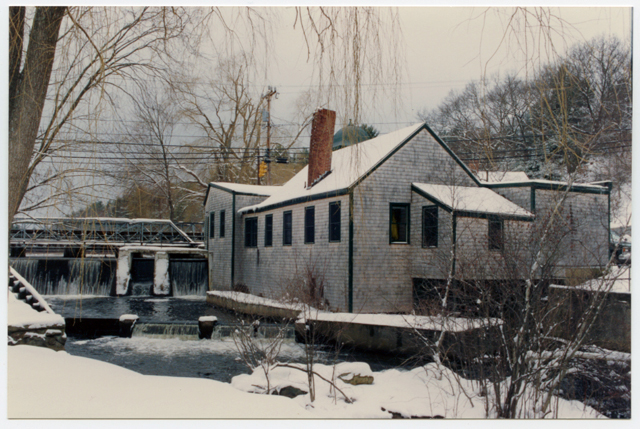
Sources: PC-14 Kingston Water Department; Vertical File: Water Department; Life on the River: The Flow of Kingston’s Industries (Elliott, 2005)
On April 12, 1886, workers broke ground for the construction of a reservoir as part of Kingston’s new municipal water system. Located just south of Russell Pond off Round Hill Road, the reservoir was used by the Water Department until 1996.
In his paper “Problems of the Water Department” read before the Jones River Village Historical Society on February 8, 1930, C.B. Hudson reported that
the reservoir is about 47 feet in diameter and 30 feet deep and was originally built of brick but, after several years of service, serious leaks developed in the bottom and a new cement bottom was laid over the original brick, and in 1923 when it was desired to increase the capacity of the reservoir it was completely relined, sides an bottom with 12” of concrete reinforced with steel bars and the new wall was carried to a height of 12 feet above the ground level which increased its capacity to about 400,000 gallons.
Sometime before the 1923 renovation, Emily Drew photographed members of her family — her brother Clarence, his wife Charity and their children Norma and Bud — at the reservoir.
Sources: Vertical File: Water Department; PC14 Kingston Water Department Papers; Through Emily’s Eyes.